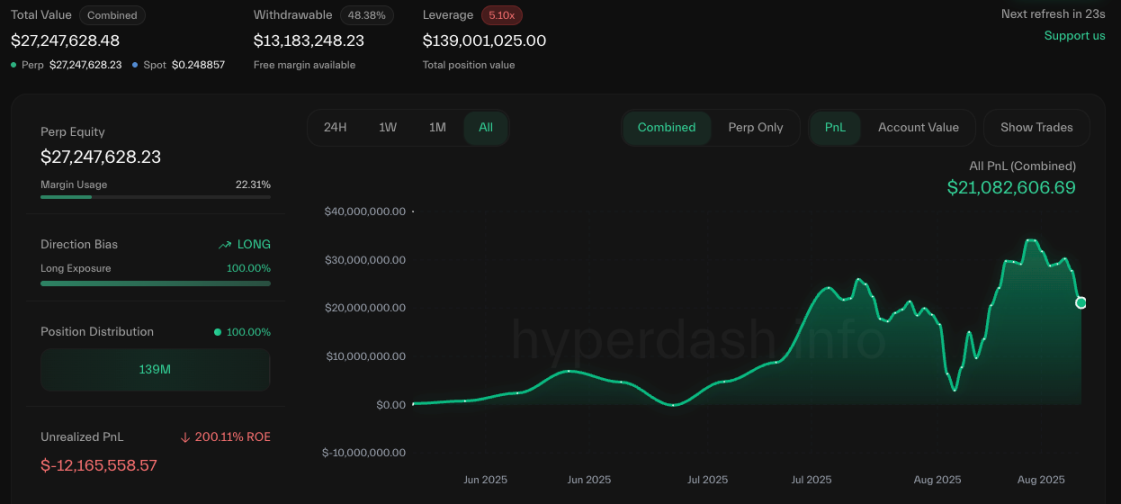NFT whales turn to Hyperliquid: The trading journey of Huang Licheng, the big brother of MajiRecommended Articles
Original author: ChandlerZ, Foresight News
Following the early large-scale purchases of blue-chip projects such as BAYC and Azuki in the NFT market, Taiwanese musician Huang Licheng (nicknamed “Big Brother Machi”) began to turn to the decentralized contract platform Hyperliquid in May 2025, and left a series of eye-catching transaction records in just a few months.
Hyperliquid’s trading data reveals Huang Licheng’s investment trajectory, a distinct roller-coaster ride. Overall, his win rate was a staggering 92.11%, with 70 of his 76 trades profitable and only 6 losses. Looking at the broader profit curve, his account peaked at $35 million in unrealized profits in early August 2025. However, just a few days later, with the market correction, his net book value plummeted to less than $3 million on August 3rd, virtually wiping out all of his earlier profits.

Huang Licheng’s account curve swings greatly between peaks and troughs, reflecting the typical characteristics of a high-leverage player. He may become rich in a short period of time, but he may also return to the starting point at any time.
The contract trajectory of Maji’s Hyperliquid
On May 16th, Lookonchain monitoring revealed that Taiwanese singer Huang Licheng (also known as Machi Big Brother) deposited 6.04 million USDC into a Hyperliquid account. Seven transactions were made in the first week, primarily long positions in ETH and HYPE, all of which resulted in a profit, netting $669,600 USD.
He then expanded his funds to $6.7 million, buying 218,866 HYPE tokens at an average price of $30.63 and staking them. Within a week, his total funds grew to $8.2 million, generating a profit of over $2.1 million.
At the end of May, he continued to increase his holdings, establishing a long position in ETH at around $2,654, while also expanding his HYPE position. From June to July, as the market rallied, his unrealized profit increased rapidly. By late July, his paper profit had reached $22.45 million.
However, the market experienced a pullback in early August. By August 3rd, Huang Licheng had essentially lost all of his approximately $22.45 million in profits from long positions in ETH, HYPE, and PUMP. He had begun longing HYPE in mid-May at $27.50 through spot and futures trading, and in late May, longing ETH at $2,654. His profits peaked at $22.45 million in late July. However, as the broader market corrected in August, his long positions began to lose money.
The market took a turn for the better. With the breakthrough and rise of ETH, Huang Licheng closed all his long positions on August 13, with a total profit of more than 33.8 million US dollars.
Despite this, he chose not to stop. On August 15, he continued to increase leverage, opening a 25x leverage on ETH, holding 21,900 ETH (worth approximately $100 million), and opening a 40x leverage on BTC, holding 50 BTC (approximately $5.9 million).
On August 20, as the market continued to fall, the floating loss of his long position expanded to US$13.68 million, with the ETH liquidation price being approximately US$3,115.

In terms of specific assets, ETH was his primary source of profit. 22 ETH trades generated over $7.5 million in profits, including a single long position closed on August 13th, which yielded nearly $16 million in profits, a landmark event. Bitcoin also provided positive returns, with cumulative profits approaching $940,000. In comparison, the platform token HYPE’s contribution was relatively modest, with total profits in the $200,000 range. However, PUMP became the biggest drag on the account’s performance, with cumulative losses exceeding $5.6 million across 14 trades, nearly offsetting the profits from the ETH portion.
Judging by his holding patterns, he’s not simply a short-term trader. His average holding period is nearly 55 hours, with some positions held for over 20 days. For example, a long position in HYPE on June 21st was held for over 600 hours, ultimately generating a profit of $820,000. This trading style demonstrates his flexibility in short-term, quick-entry and exit trades, while also holding onto long-term positions to await market reversals. However, this strategy carries significant risks. If the market moves against him, it could lead to sustained, substantial losses, as happened with PUMP.
Overall, Huang Licheng’s investment performance in Hyperliquid is both impressive and fragile. While ETH’s massive profits have bolstered the company’s overall image as a “winner,” losses in a single asset can quickly erode gains.
From Big Brother Machi to NFT Whale
Huang Licheng, nicknamed “Big Brother Machi,” was once a well-known figure in the Chinese music and variety show scene, but in recent years he has gradually shifted his focus to the kripto market. As early as 2021, he became active in the NFT market and quickly became a well-known whale investor. He once made a large purchase of BAYC (Boring Ape) and held it for a long time. He also gave NFT to celebrity friends such as JJ Lin and Xu Jinglei, bringing these digital collectibles into the public eye.
In 2022 and 2023, he made numerous large moves in and out of blue-chip projects like Azuki, triggering significant market fluctuations. In July 2024, he even increased his holdings by purchasing 23 BAYC NFTs in a short period of time, bringing his total holdings to over 60. It was widely believed that he hoped to link BAYC NFTs to tokens through the new ERC-404 protocol “APE Fi,” seeking arbitrage or liquidity expansion. However, the initial enthusiasm for the project quickly faded, and the prices of tokens and NFTs remained largely unchanged. The lack of liquidity made it difficult for him to liquidate his newly acquired holdings.
Such high-risk attempts are not uncommon in his investments. In March 2024, Bobaoppah, the Solana MEME project initiated by Huang Licheng, raised 200,000 SOL tokens, equivalent to $38 million at the market price at the time. However, a few months after the project launched, the token price nearly halved, and the liquidity pool shrank to approximately 5% of the original fundraising amount, leaving many backers with losses.
Huang Licheng also frequently bet on emerging tokens. For example, he invested $15.35 million in FRIEND, becoming its largest individual holder. However, the token’s price plummeted, resulting in a paper loss of over 90%. He also spent $4.65 million on BLAST and recorded a loss of approximately 50% when he sold BLUR. In just a few months, his cumulative losses on various projects approached $20 million.
Huang Licheng’s NFT investments haven’t always been smooth sailing. He’s repeatedly announced his exit from the NFT market, only to quickly reenter it at lower prices. By 2025, as Hyperliquid gained popularity, his focus began to shift toward the more leveraged and volatile derivatives market.
There are few winners in the big casinos
In a highly leveraged market environment, even traders with large amounts of capital find it difficult to maintain positive returns over the long term.
According to data from the on-chain monitoring account @ai_9684 xtpa, as of August 19th, only three accounts among the top 20 positions on the Hyperliquid platform were in a state of floating profit, while the remaining 85% were in a state of floating loss. Even if the scope is expanded to the top 100 positions, only 34 addresses are still profitable. In other words, the majority of positions are either in a state of floating loss or liquidation, and individual profitable cases are often just temporary exceptions.

Huang Licheng wasn’t the only one to endure the drastic fluctuations. According to analyst Yu Jin, as of August 15th, the positions of three highly leveraged Hyperliquid whales had been wiped out, with cumulative losses exceeding $140 million.
- James Wynn Real: It had a peak profit of $87 million at the end of May, but its $1.23 billion Bitcoin long position ultimately lost $21.77 million;
- “Insider Whale” qwatio: From $3 million in capital to $26 million, he then lost everything along with his principal and interest;
- AguilaTrades: Continuing to open highly leveraged positions despite multiple liquidations, with cumulative losses currently exceeding $37.5 million.
This is the norm for Hyperliquid and the entire highly leveraged derivatives market. Profits and losses go hand in hand, and risk and reward come from the same source. In such an environment, winners are always a minority, while the majority end up as floating losses in the data.
Meanwhile, Hyperliquid is reaping huge profits in the industry. Matthew Sigel, head of digital asset research at VanEck, has published an article stating that Hyperliquid’s revenue will account for 35% of the blockchain industry by July 2025. This means that while most traders lose money on the platform, Hyperliquid itself stands to benefit the most.

Some gamblers at the card table become rich overnight, while others lose everything in an instant, but no matter who wins or loses, the casino always takes a stable amount of chips.
For Hyperliquid, the ups and downs of Huang Licheng, James Wynn Real, or qwatio are just part of the capital flow; the real player who is sure to make profits is always the platform itself.
Artikel ini bersumber dari internet: NFT whales turn to Hyperliquid: The trading journey of Huang Licheng, the big brother of MajiRecommended Articles
Related: Interactive Tutorial | Seize the last testnet mining opportunity before Nexus mainnet
Original | Odaily Planet Daily ( @OdailyChina ) Author | Asher ( @Asher_0210 ) On June 24, Nexus officially launched the last round of testnet mining (Testnet III) before the mainnet. This round of testing is not only open to mainland China, but also introduces a mechanism for points to be exchanged for test tokens. Next, Odaily Planet Daily will take you to seize the last mining bonus before the Nexus mainnet. Nexus: A parallelized proof-of-stake mining network Nexus Network is a parallelized proof-of-stake mining network, where Nexus zkVM is a modular, scalable, open source, highly parallelized, validator-optimized, contributor-friendly zkVM written in Rust, with a focus on performance and security. Whether it is a laptop or a mobile phone, Nexus makes it easy for anyone to contribute computing resources. With…







